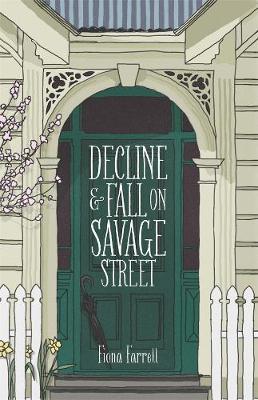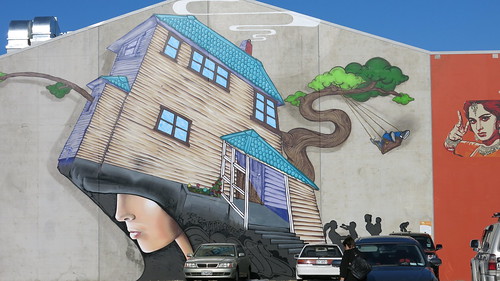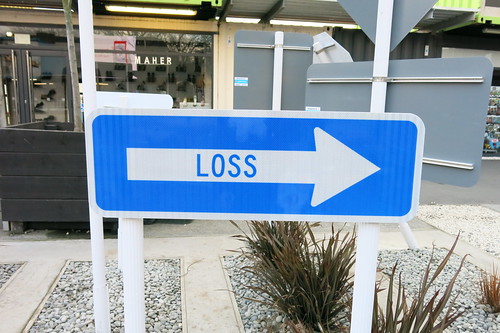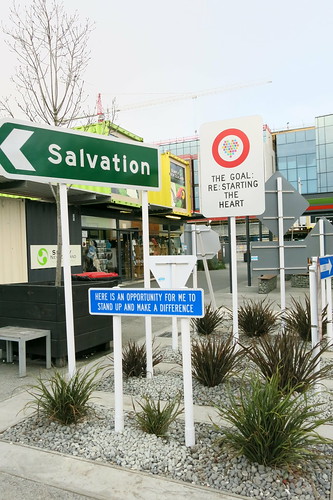I am standing next to the old Government Building in Christchurch. It's early morning and the air is crisp and smells of expectations. In front of me is the cathedral in ruins. But from where I stand, I can also see a new building coming up. The new central library, with its promise of healing ...
 I am waiting here to meet Fiona Farrell to talk about her new book, which has been launched last week. Decline and fall on Savage Street, a fiction sister to non-fiction The villa at the edge of the empire, is yet another joyful gift with sophisticated form, lovable characters, relevant issues and healing properties that should not be underestimated.
I am waiting here to meet Fiona Farrell to talk about her new book, which has been launched last week. Decline and fall on Savage Street, a fiction sister to non-fiction The villa at the edge of the empire, is yet another joyful gift with sophisticated form, lovable characters, relevant issues and healing properties that should not be underestimated.
Congratulations Fiona, for another beautiful gift that you have given to the city of Christchurch and also to the wider community.
Thank you.
I was really impressed by the form of this book. It's a novel but at the same time, each chapter works on its own like a short story and it stands on its own like a delicately crafted jewel. I was wondering where did the idea for the form come from?
From the city itself, from the fact that everything seemed to be falling into little bits. When I started writing The Villa at the edge of the empire, the fact one, that's a twin to this one, I wrote that in small chunks. I thought of them as bricks or little pieces of timber, salvageable, and then you put them all together to make a shape, so it was like a salvage operation.
I also felt that it's wasn't just the physical destruction of the city, but what I was feeling as an older woman who has lived here for nearly 70 years, was the demolition of a social structure that sustained people, and its replacement with lots of individualist policies and theories that are affecting the way people live in this country. It felt like it wasn't just a physical demolition, but a social and political one. So I wanted to put all these little bits together and try and reconstruct a sort of history out of all these bits and pieces. A bit like a Kiwi crib, when you knock all your bits together, I think that's very New Zealand style.
The whole story is a great portrait of the 20th century. The history is often happening in the background, but the reader is constantly aware of it. I had a feeling that all the way through the story, the terrifying events in history were somehow distant, they were happening far away and to others. Only with the earthquake it becomes real and is happening to characters of the story. People are suddenly part of this terrible history.
Yes, it becomes very intimate and personal with the quake. One of the challenges in writing the book was to find a little link between an event (like World War Two), a personal intimate link with here and something that would leave its mark on a house, particularly this individual house in this imagined street.
Sometimes it would be because someone remembered the house. The man in World War Two, who is wounded, has a photograph of the corner of the house. Later on in the story, there's a painting of him by a woman that he wanted to marry, who lives in a house. This painting has a shadow under a tree, which is a reference to him. So it would be a link like that, or someone might be directly involved in a major event, like WWII, or there might be a kind of echo of it. Like with Eric, the agent, who behaves like the McCarthy-ist spies in America, but does it in this little house.
Sometimes it's a sort of an echo, and sometimes it's a metaphor. So when the Berlin Wall falls down and all the barriers collapse in other parts of the world, it's the kitchen wall that's been taken down in the house, and two families are blended together. So sometimes it's a metaphor, sometimes it's an actual link.
Eric is one of the characters that I really didn't grasp. He was the most mysterious figure in the whole story for me, but I did get a feeling that he might be a spy.
Yes, well, he's an agent. He's an agent of the government survey of the people who were suspected to be communists in the late 40s and 50s. There was this kind of anti-communist agitation here, as it was all over the world, in places like America and Britain. People were singled out if they were suspected of having communist sympathies. So he's just an echo of that over here in Christchurch.
The other thing I was very impressed by was the form of each chapter, the way you form the beginning and the end. It seems very simple, but it's extremely powerful because it gives you a feeling of a flow that's beyond human control, that life is so much bigger and complex and stretches beyond the single events that are portrayed in the book.
I like leaving the beginning and the end of the chapter ragged, so you come in with a few dots in the middle of the sentence. Again it's a part of that salvaging, it's that the story is just a little piece that's been salvaged and there's a whole lot of other stories. So I've just got this one which has got torn edges and it doesn't properly end either, it's got a torn ending. So that story can continue out of sight.
I always think fiction is what you read, the story on the page, but then there are all the other stories that are implied within that book. That's a sort of thing that's been rather fashionable I suppose in the last 20 years or so, to make books out of minor characters for example or to say what would happen if something else had eventuated, to reframe the known story. That's a sort of thing I'm working on as well, that idea that there's a whole other narrative, a great big narrative, and you just choose this little bit. That's the bit that you pick up from a ground, it's just that little brick and you pick it up and you hold that one up. It's kind of salvaging operation.
At the same time, that little brick tells the wider story as well, it's so entwined in its context, which can have social, political, economic, environmental weight ... so you can actually see a whole house in that little brick. I think that's very hard to achieve and is at the same time the beauty of fiction.
Yes, that's exactly right. In this particular fiction, it's always a problem how you're going to shape the material and tell a story. For me, it always has to start with structure. I always have to have a shape in my head. Other people might start with a character, or an event, or something like that, but for me, it's a shape
I often find, when I'm talking about my books, I do this – an arch (Fiona draws an arch with her hand in the mid air) or a span. In this one, the shape is one hundred little pieces and once I have that in my head, once I have a shape clear, and the way I'm going to present it, everything falls into place. That dictates what I can tell, how long the book can be. It dictates how much you can actually pack into a short chapter, it gives you a very precise formula in which you can work.
It sounds a bit dry, but for me, it's very reassuring, because it's such a massive material and you could just tell a great sweeping saga that went straight through from A to B, but for me, it feels more comfortable. I feel at ease, writing this small precise pieces and it makes me very, very particular and very concentrated. It's like writing a poem or a short piece of fiction. So I have to be economical, but I have to pack into that something about the character, I have to move the narrative forward, I have to put the reference to the house, there are particular things that I have to do within that tiny shape and it disciplines me.
I have noticed the voices of characters came through very well in each chapter. You can tell straight away which character is telling the story. I think you captured those voices really well.
I really enjoyed writing them all, I loved writing Poppy, she was my favourite. I liked all of them, even Eric in his funny, disturbing way.
I was really fascinated by the power of your imagination, I think it shines in the scope of various people who lived in the house and their stories. Where do you get the ideas from? There is such an abundance of them in this book.
The problem I have is too many ideas. The problem is limiting them. That's really the problem I have, it's the selecting.
Wow. It must be nice to have that problem, as a writer, I guess?
I don't think it's necessarily an advantage. It's not an advantage to have loads of ideas because you still have to select and still have to discipline yourself, you have to restrain, what can happen, and make choices. It doesn't necessarily make it any easier.
I guess that's when your form helps.
It does, because it let me write lots of different little stories, which I enjoyed. And I also liked discovering history, things that I found by coming to the library and looking through the microfilm. I still like sitting in the library and finding all material that's there.

If we return back to the characters, and I might be a bit biased here, but I got a feeling that women characters are really holding up the households in the house all the way through the book until the earthquake hits. That's when female character Janey intuitively gives up and her husband Rob is trying to save the situation and is trying to hold it all together.
Yes, that's true particularly for the first part, when Violet is there for a long long time. And I suppose Min and the hippy commune as well. I wanted to try to keep the balance, because history is often told from a male point of view and particularly in this country, or anywhere really. It can very often be a history of great male figures. I'm an old 70s feminist and we've been fighting that one for a very very long time. All my life really. It's also that I do know how female characters work. I'm less secure when I'm writing male characters. I can understand the complexities of a female thinking. I wanted to try to keep the balance.
I think it is a good balance, especially with Rob, he balances it out. And Paul as well.
I loved Rob. He keeps on trying to make his pizza oven, I thought he was gorgeous.
It was very interesting to observe different timelines, which exist in the novel. One is the human-scale time. The other two are much slower and they belong to the natural world, have their own rhythm. Again, these two timelines, one of the river and the other of the earth, they create a different perspective of events. They give the perspective of human insignificance compared to the natural world, a reality that just passes by in its own slow rhythm.
Yes, and very magical and wonderful one. I find eels, the journey of those big female eels when they're eighty, ninety, hundred years old, back up to spawn, amazing. How that's imprinted in a thing that's a size of a whitebait on arrival! I'm just in awe of the natural world, and I've become more so as I get older. It just seems more and more extraordinary. And valuable and a real corrective to human self-importance. We just have to do the best we can here, and live as well as we can, but make it possible for everything else to live as well. We really have been on a crazy path.
I think out of your characters Sybil is the one most connected to the natural world.
She is, though she never moves outside of the house and garden, she stays there all her life, so she's the one who lives the most restricted life in some ways. I wanted to show that idea that you can have this tiny, little, precise, fixed environment, but it's got everything in it. If you just want to look at it. She looks, she's the one who sees things. Partly because she's been damaged slightly by almost drowning, after falling off the raft. But she sees the world very clearly and understands the beauty of animals and plants. She never moves much beyond the gate, very rarely.
Though she lives very rich life, she's mostly turned inwards. And outwards to the beauty around her. I really liked her.
I did too. Solid little lady in her little grubby old dungarees. She's great, little witch lady.
But also very strong at the same time.
Yes, she's very determined, very strong, sure about who she is and what she's doing. Yes, I liked her.
There are also many metaphorical layers in your novel. A lot of metaphors are kept in the frame of each chapter, but many flow all the way through the book. The most compelling one for me was the image of the architect at the beginning of the narrative. I saw it as a metaphor for a writer, who's crafting lives of characters. Throughout the book it gains even greater importance, it's almost a god-like figure. I imagined you in this figure of an architect.
It's the story of creation. The Biblical story is the creation of the chaos and there's the world, the natural world, and the God creating everything. But that's the story of creation as an over-reaching western myth, or for some people it's belief. But it's also what actually happens, this idea of random existence and the way we create structures out of random events, whether they're the way we interpret something that's happened and make narratives out of it, or, whether we decide we need a shelter and we assemble lots of random pieces together from all over the place and we make a shelter for ourselves.
Because we need shelter, we're a naked little animal without a shelter. It's a necessity for us as a creature. What I liked about the architect is partly that he adds a little tower. He's doing something very practical and right at the end, just before he goes off for his lunch, he adds a little detail, which is just a silly little tower, little turret with a room in it. And because of that tower, because he added that to the house, certain kinds of people keep getting attracted to the building, because it's got a kind of romantic playfulness. There's sort of joy in it. And each of them brings their own imagery to the idea of the tower or the turret.
What interests me is that the house never really grows into a character. It stays in the centre of the novel, it works as a setting, becomes a home and a sanctuary for so many generations, until the end, when it gets demolished and I think that's when it becomes the most alive. It explodes into life.
Yes, just like the eel, living its 100 years and then it explodes. I love that. It wasn't something I planned, but I love it. Thank you. I'm glad that's how it seems.
This book is a perfect read for someone who hasn't experienced the Christchurch earthquake and post-earthquake situation but is intrigued in how it must have felt, how it must have been on a personal level. I think you captured the aftermath, all the emotions, frustrations and everyday struggle extremely well. Only art allows us to capture life in such ways.
Yes, exactly, I think so too. I think there's a certain amount you gain from reading facts, of course there is. You can read books about places or events, which are factual and have enormous power. But to really find out, to get in the intimate part of it, how it affects things like, how you are in bed with someone, or how a child feels, you do it through fiction. Often children's feelings about war or big national or international events are at a distance or very limited. That's what fiction can do, it's investigative and curious.
According to Dale Spender and his work The mothers of the novel, the novel developed as a female form. It developed at the same time as men were going off on voyages of exploration and scientific enquiry, coming to New Zealand, apart from anywhere else. But women were not able to do that, and so stuck at home, within those four walls, they started speculating and investigating through fiction. And that's how the novel started, at least in the English language, I don't know if it's the same across Europe. It was disregarded as something trivial, frivolous, something that was not important. That's a sort of thing that you have all the time in Jane Austen: reading novels is a waste of time, it's not important. She's writing out of that kind of environment, but there were hundreds and hundreds of novels being written.
It's always been investigative, a kind of scientific experiment. You are working on an experimental level, you're saying, if I put these things together, what might happen. It's a really profound art form. I really love fiction. That's why I wanted to try to write about this. It was difficult, but I did want to try to write about this big event.

It's interesting what you refer to in your note at the end of the book – that the first novel about WWII, Elizabeth Bowen's The Heat of the day, was written three years after the war finished.
Yes, the first that I could find anyway, yes. I think the difficulty is to get the mind calm enough to be able to write about such big events. And it is a kind of individualist expression and you do need a degree of calm to be able to do it. Just to be able to put the words on the page really.
You also need enough distance, a perspective, which takes time, I guess.
Yes, and the Heat of the day is a very peculiar book. It's very sexual, that's the thing that's the most dominant about it. It's about these fleeting sexual encounters in London after the Blitz. That's possibly the expression of her personality, but also part of that confusion. It's very primal. I think it does require distance, it's quite confused book. I was trying to avoid that, keeping it very precise and very clear.
If we touch on political issues in the book, first of all, I really like the nickname - Big Buffoon. It's very clear who that refers to.
Well, Rob can't stand him. It's a character, it's not me.
Rob is very very angry and frustrated. I think a lot of people will easily relate to him.
That's the other thing you can do in fiction, you can express multiple points of view of any given event. It's not just one monolithic variation of how things are.

I think a lot of political issues that are expressed through characters in this book are done so in a very powerful way. When I was reading Liz's story, I got so angry.
Yes, about women, not being able to access abortion. Absolutely. That's based to some extent on a book by Margaret Sparrow, who was a doctor in Wellington, who fought to have abortion made legal. She, like a lot of people, who fought that particular battle, assembled a book of oral histories called Abortion then and now, which includes first person accounts of what it was like to get an abortion in an illegal way, in someone's front room or back room. And the fear of it and sordid things that happened as a result of that. These women were often very young, very vulnerable and desperate, so people were able to exploit that. Not just financially, but also in other ways.
What happens in the novel is actually what people have reported. Not just once, that's been the experience of loads of women. This issues had been raised again in this election. The prime minister has already flagged that he's opposed to abortion. It may be something that comes up in the next term, who knows.
I think a lot of issues that are present throughout the story are extremely relevant to what's happening today: war, conscientious objection, immigration issues, gender inequality, environmental problems ...
Possibly that's because whenever you write a historical novel, you're actually writing about now. You're writing about the past, but you're really writing about now. It doesn't matter what it is. The novels about Henry VIII or Queen Elizabeth I, they are to some extent reflections of our curiosity about celebrity. We are interested in clothes, in the machinations, just as we are in people like Trump.
The 20th century is a long period, but on some level, it's also very short period and we are still engaged in it. We are still dealing with political things that were founded at the beginning of the 20th century, we're still in those political parties, we're still dealing with the same sorts of issues and they are not going to go away. It's an ongoing flood. Like the river. And we are caught in it.
Thank you very much, Fiona. Would you like to share anything else about the book?
I hope that people find it a rich book. That's what I really hope. That they'll find things they're interested in, or they share some of the feelings of the characters, that they can see them and that it's vivid enough. I just hope it's a rich book, with lots of pleasures for a reader. That's what I'm hoping.
Well, it definitely is for me.
Find out more:
- borrow non-fiction twin The Villa at the edge of the empire
- browse our catalogue for more brilliant Fiona Farrell books
- read other posts about Fiona Farrell






Add a comment to: A hundred shards of potent remedy: an interview with Fiona Farrell about Decline and Fall on Savage Street